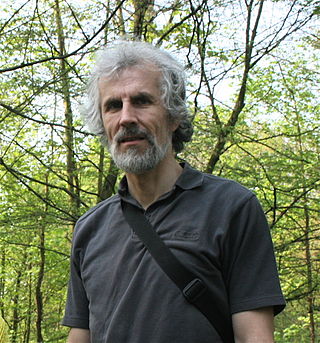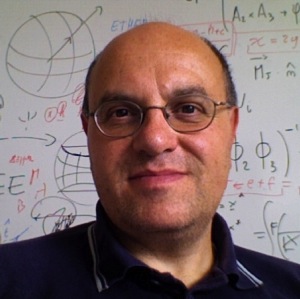Related Research Articles
Process philosophy, also ontology of becoming, or processism, is an approach in philosophy that identifies processes, changes, or shifting relationships as the only real experience of everyday living. In opposition to the classical view of change as illusory or accidental, process philosophy posits transient occasions of change or becoming as the only fundamental things of the ordinary everyday real world.

Biophysics is an interdisciplinary science that applies approaches and methods traditionally used in physics to study biological phenomena. Biophysics covers all scales of biological organization, from molecular to organismic and populations. Biophysical research shares significant overlap with biochemistry, molecular biology, physical chemistry, physiology, nanotechnology, bioengineering, computational biology, biomechanics, developmental biology and systems biology.

In fluid dynamics, a vortex is a region in a fluid in which the flow revolves around an axis line, which may be straight or curved. Vortices form in stirred fluids, and may be observed in smoke rings, whirlpools in the wake of a boat, and the winds surrounding a tropical cyclone, tornado or dust devil.
Computational neuroscience is a branch of neuroscience which employs mathematics, computer science, theoretical analysis and abstractions of the brain to understand the principles that govern the development, structure, physiology and cognitive abilities of the nervous system.

Computational fluid dynamics (CFD) is a branch of fluid mechanics that uses numerical analysis and data structures to analyze and solve problems that involve fluid flows. Computers are used to perform the calculations required to simulate the free-stream flow of the fluid, and the interaction of the fluid with surfaces defined by boundary conditions. With high-speed supercomputers, better solutions can be achieved, and are often required to solve the largest and most complex problems. Ongoing research yields software that improves the accuracy and speed of complex simulation scenarios such as transonic or turbulent flows. Initial validation of such software is typically performed using experimental apparatus such as wind tunnels. In addition, previously performed analytical or empirical analysis of a particular problem can be used for comparison. A final validation is often performed using full-scale testing, such as flight tests.

Dynamical systems theory is an area of mathematics used to describe the behavior of complex dynamical systems, usually by employing differential equations or difference equations. When differential equations are employed, the theory is called continuous dynamical systems. From a physical point of view, continuous dynamical systems is a generalization of classical mechanics, a generalization where the equations of motion are postulated directly and are not constrained to be Euler–Lagrange equations of a least action principle. When difference equations are employed, the theory is called discrete dynamical systems. When the time variable runs over a set that is discrete over some intervals and continuous over other intervals or is any arbitrary time-set such as a Cantor set, one gets dynamic equations on time scales. Some situations may also be modeled by mixed operators, such as differential-difference equations.
In fluid dynamics, helicity is, under appropriate conditions, an invariant of the Euler equations of fluid flow, having a topological interpretation as a measure of linkage and/or knottedness of vortex lines in the flow. This was first proved by Jean-Jacques Moreau in 1961 and Moffatt derived it in 1969 without the knowledge of Moreau's paper. This helicity invariant is an extension of Woltjer's theorem for magnetic helicity.

Francis Paul Heylighen is a Belgian cyberneticist investigating the emergence and evolution of intelligent organization. He presently works as a research professor at the Vrije Universiteit Brussel, where he directs the transdisciplinary "Center Leo Apostel" and the research group on "Evolution, Complexity and Cognition". He is best known for his work on the Principia Cybernetica Project, his model of the Internet as a global brain, and his contributions to the theories of memetics and self-organization. He is also known, albeit to a lesser extent, for his work on gifted people and their problems.

Biological or process structuralism is a school of biological thought that objects to an exclusively Darwinian or adaptationist explanation of natural selection such as is described in the 20th century's modern synthesis. It proposes instead that evolution is guided differently, by physical forces which shape the development of an animal's body, and sometimes implies that these forces supersede selection altogether.

Biological organisation is the organisation of complex biological structures and systems that define life using a reductionistic approach. The traditional hierarchy, as detailed below, extends from atoms to biospheres. The higher levels of this scheme are often referred to as an ecological organisation concept, or as the field, hierarchical ecology.
The branches of science, also referred to as scientificfields or scientific disciplines, are commonly divided into three major groups:
Neurophysics is the branch of biophysics dealing with the development and use of physical methods to gain information about the nervous system. Neurophysics is an interdisciplinary science using physics and combining it with other neurosciences to better understand neural processes. The methods used include the techniques of experimental biophysics and other physical measurements such as EEG mostly to study electrical, mechanical or fluidic properties, as well as theoretical and computational approaches. The term "neurophysics" is a portmanteau of "neuron" and "physics".

Living systems are life forms treated as a system. They are said to be open self-organizing and said to interact with their environment. These systems are maintained by flows of information, energy and matter. Multiple theories of living systems have been proposed. Such theories attempt to map general principles for how all living systems work.
Physical knot theory is the study of mathematical models of knotting phenomena, often motivated by considerations from biology, chemistry, and physics. Physical knot theory is used to study how geometric and topological characteristics of filamentary structures, such as magnetic flux tubes, vortex filaments, polymers, DNAs, influence their physical properties and functions. It has applications in various fields of science, including topological fluid dynamics, structural complexity analysis and DNA biology.
In engineering, physics, and chemistry, the study of transport phenomena concerns the exchange of mass, energy, charge, momentum and angular momentum between observed and studied systems. While it draws from fields as diverse as continuum mechanics and thermodynamics, it places a heavy emphasis on the commonalities between the topics covered. Mass, momentum, and heat transport all share a very similar mathematical framework, and the parallels between them are exploited in the study of transport phenomena to draw deep mathematical connections that often provide very useful tools in the analysis of one field that are directly derived from the others.
Topological ideas are relevant to fluid dynamics at the kinematic level, since any fluid flow involves continuous deformation of any transported scalar or vector field. Problems of stirring and mixing are particularly susceptible to topological techniques. Thus, for example, the Thurston–Nielsen classification has been fruitfully applied to the problem of stirring in two-dimensions by any number of stirrers following a time-periodic 'stirring protocol'. Other studies are concerned with flows having chaotic particle paths, and associated exponential rates of mixing.
In differential geometry, the twist of a ribbon is its rate of axial rotation. Let a ribbon be composed of a space curve, , where is the arc length of , and the a unit normal vector, perpendicular at each point to . Since the ribbon has edges and , the twist measures the average winding of the edge curve around and along the axial curve . According to Love (1944) twist is defined by

Renzo Luigi Ricca is an Italian-born applied mathematician, professor of mathematical physics at the University of Milano-Bicocca. His principal research interests are in classical field theory, dynamical systems and structural complexity. He is known for his contributions to the field of geometric and topological fluid dynamics and, in particular, for his work on kinetic and magnetic helicity, physical knot theory and the emergent area of "knotted fields".
The governing equations of a mathematical model describe how the values of the unknown variables change when one or more of the known variables change.

Alain Goriely is a Belgian mathematician, currently holding the statutory professorship (chair) of mathematical modelling at the University of Oxford, Mathematical Institute. He is director of the Oxford Centre for Industrial Mathematics (OCIAM), of the International Brain and Mechanics Lab (IBMTL) and Professorial Fellow at St Catherine's College, Oxford. At the Mathematical Institute, he was the director of external relations and public engagement, from 2013 until 2022, initiating the Oxford Mathematics series of public lectures. In 2022, he was elected to the Royal Society., and Gresham Professor of Geometry at the Gresham College (London) in 2024.